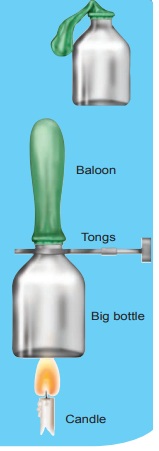Heat and Temperature | Term 2 Unit 1 | 7th Science - Student Activities | 7th Science : Term 2 Unit 1 : Heat and Temperature
Chapter: 7th Science : Term 2 Unit 1 : Heat and Temperature
Student Activities
ACTIVITY 1
What is required?
A small glass bottle, a rubber cork, an empty refill, water, colour, a candle, a fork, a paper.

What to do?
• Take a small glass bottle. Fill it with coloured water.
• Make hole at the centre of the rubber cork.
• Pass empty refill from the hole of the rubber cork.
• Make the bottle air tight and observe the water raised in the refill.
• Make a scale on paper, place it behind the refill and note down the position of the surface of water.
• Hold bottle with fork and supply heat to it with candle. Then observe.
What is the change in the surface of water?
The surface of water level rises up.
• Stop the supply of heat. When water is cooled, observe the surface of water in the refill, what change takes place? Why?
The surface of water level goes down because water contracts when it is cooled.
When, a liquid is heated, it expands and when it is cooled down, it contracts.
ACTIVITY 2
What is required?
A big bottle, a balloon, threads, candle, water, fork

What to do?
• Take one big bottle, and fill some water in it.
• Attach one balloon on the mouth of bottle and fix it with thread.
• Hold bottle with a fork. Heat the bottle with a candle and take observation.
• What change occurs in the state of balloon after heating the bottle?
The balloon expands and becomes erect and swollen.
• What change occurs in the state of balloon after heating the bottle?
Why?
Because the air in the bottle expands due to heat.
Now, let the bottle get cooled down.
What change occurs in the state of balloon after bottle gets cool down? Why?
The balloon shrinks in size and folds down.
When gases substance gets heat, it expands; when it cools it contracts. Why does a tyre get burst in summer?
As it is very hot in summer the air in the tyre expands greatly. The pressure created by the expanded air causes the tyre to burst.
ACTIVITY 3
Measure your body temperature
Wash the thermometer preferably with an antiseptic solution. Hold it firmly by the end and give it a few jerks. These jerks will bring the level of Mercury down. Ensure that it falls below 35°C (95°F). Now place the thermometer under your tongue or arm pit.
After one minute, take the thermometer out and note the reading. It tells you your body temperature. What did you record as your body temperature?
ACTIVITY 4
Use of Laboratory thermometer
* Take some water in a beaker.
* Take a laboratory thermometer and immerse its bulb end in water; holding it vertically. Ensure to dip whole portion of bulb end. The bulb end should not touch the bottom or side of the beaker.
* Observe the movement of rise of mercury. When it becomes stable, take the reading of the thermometer.
* Repeat this with hot water and take the reading.
(i) The reading of mercury level in ordinary water 35°c
(ii) The reading of mercury level in hot water 75°c
ACTIVITY 5
Use of Digital thermometer

1. Wash the tip with warm (not hot), soapy water.
2. Press the "ON" button.
3. Insert the tip of the thermometer into the mouth, bottom, or under the armpit.
4. Hold the thermometer in place until it beeps (about 30 seconds).
Read the display.
5. Turn off the thermometer, rinse under water, and put it away in a safe place.
Maximum _ minimum the rmometer
The maximum and minimum temperatures of the previous day reported in weather reports are measured by a thermometer called the maximum - minimum thermometer.
Most of the people in the world use the Celsius scale to measure temperature for day to day purpose. The Kelvin scale has been designed in such a way, it is not only an absolute temperature scale, but also 1°C change is equal to a 1K change. This makes the conversion from Celsius to absolute temperature scale (Kelvin scale) easy, just the addition or subtraction of a constant 273.15
But in United States they prefer to use the Fahrenheit scale. The problem is, converting Fahrenheit to absolute scale (Kelvin) is not easy.
To sort out this problem they use The Rankine scale. It named after the Glasgow University engineer and physicist Rankine, who proposed it in 1859. It is an absolute temperature scale, and has the property of having a 1°R change is equal to a 1°F change. Fahrenheit users who need to work with absolute temperature can be converted to Rankine by
R= F+ 459.67
Related Topics